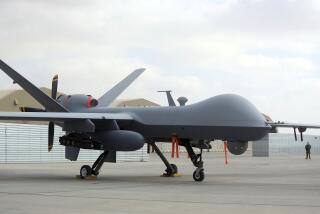U.S. Working to Avert Portable-Missile Attacks on Airplanes
- Share via
WASHINGTON — Top federal officials, increasingly concerned that terrorists will attack U.S. commercial aircraft with shoulder-fired missiles, are developing plans to thwart such strikes with measures that range from sophisticated antimissile technology to simple changes in takeoff schedules.
An interagency task force that reports to the National Security Council is also coordinating emergency inspections of large U.S. airports to determine their vulnerability to the small, portable missiles, senior officials said. And it is planning a public education campaign to teach police departments and citizens near airports to identify the missiles if they see someone assembling one.
While acknowledging their alarm at the danger of portable missiles being fired at any of the approximately 6,700 commercial aircraft operating in the U.S., administration officials stressed Tuesday that the highest echelons of the government are focused on the threat and are determined to maximize the traveling public’s safety.
“We have drawn together the best thinkers in government and in the contracting world” to address the issue in recent months, said one senior government official. “We now grasp the threat, and we grasp our options.”
U.S. air carriers, already staggered by financial losses caused in part by the Sept. 11 terrorist attacks, are arguing that the government should bear the cost of any required high-tech equipment, which could carry billion-dollar price tags.
“Protecting our citizens and defending our nation against threats of this type is the responsibility of our federal government,” said Michael Wascom, a spokesman for the Air Transport Assn., which represents U.S. carriers. “As with any aspect of providing for our national defense, this subject is best addressed by our government.”
U.S. military and intelligence officials have been aware of the dangers presented by shoulder-fired missiles for decades, and in the days after the terrorist attacks initiated high-level meetings on the possible danger. But two recent missile attacks against aircraft added to the sense of urgency.
In May, a Russian-built SA-7 missile was fired at a U.S. military jet taking off from Prince Sultan Air Base in Saudi Arabia but missed its target.
On Nov. 28, two missiles of the same brand and factory batch as the one used in Saudi Arabia were fired at an Israeli jetliner seconds after it took off from Mombasa, Kenya. They also streaked wide of their target, at almost the same moment that a car bombing killed 16 people and destroyed an Israeli-owned hotel in Mombasa. Officials concluded that the Al Qaeda terrorist network was behind all the attacks.
Guerrilla and terrorist movements have long used the so-called man-portable missiles to bring down passenger aircraft, killing hundreds of civilians. In the 1980s, Afghan fighters repeatedly brought down Soviet helicopters with U.S.-supplied Stinger missiles.
But the Mombasa attack may have been the first time such missiles were launched against a passenger carrier far from a war zone, officials said. The attacks appeared to confirm U.S. intelligence experts’ belief that Al Qaeda has access to a supply of the weapons and may now be uncrating them as a new terror tactic.
More to Read
Sign up for Essential California
The most important California stories and recommendations in your inbox every morning.
You may occasionally receive promotional content from the Los Angeles Times.













